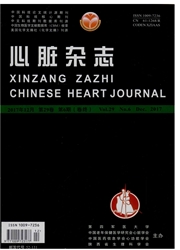

 中文摘要:
中文摘要:
目的:了解心房颤动(房颤)患者口服抗凝剂治疗过程中抗凝效果的疗效观察指标应媚情况,比较不同疗效观察指标的优缺点及适用性:方法:运用Cochrane系统评价方法,检索MEDLINE,EMBASE和Cochrane Library近10年(1998年1月~2008年1月)关于口服抗凝剂(调整剂量华法林)疗效控制指标的文献进行系统评价。相关指标包括:在抗凝目标值范围内的时间百分比(percentage of time in therapeutic range,TTR),在抗凝目标值范围内的国际标准化比值(INR)百分比等:结果:根据纳入排除标准入选文献50篇,共计68个研究组。研究样本量从25例到6454例不等(平均757例);研究或随访时间最短3个月,最长42个月(中位数12个月)。使用最多的抗凝控制指标为.TTR[占研究总数69%(45/65)]和抗凝目标值范围内的INR百分比[占研究总数37%(24/65)]。仅有9%(6/65)的研究同时采用以上两种指标,两指标间差别有统计学意义[(59±13)%vs.(53±10)%,P=0.002],同时有显著直线相关关系(r=0.988,P〈0.001)。结论:TTR和抗凝目标值范同内的INR百分比是目前最常用的抗凝控制指标。相关研究可以同时采用这两种指标,并结合其他指标使用,以弥补相互不足便于抗凝监控和比较。
 英文摘要:
英文摘要:
AIM : To evaluate different measures of oral anticoagulation in patients with atrial fibrillation (AF) and to compare the application of different measures in clinical practice. METHODS: Evidencebased method was used to search MEDLINE, EMBASE and Cochrane Library ( 1998 to 2008) for studies (with adjusted dosage warfarin therapy) reporting international normalized ratio (INR) control measures as percentage of time in range (TTR) , percentage of INRs in range, and percentage of patients in range and other same measures. RESULTS: Fifty publications with 68 study groups were identified. The sample size of studies was from 25 to 6 454 (mean 757). Duration or follow-up of studies was from 3 -42 months (median: 12 months). TFR (69%) and percentage of INRs in range (37%) were the most popular measures. Only 9% of the total studies used both measures at the same time. A significant difference was found between the two measures [ (59 ± 13)% vs. (53 ± 10)%, P =0. 0021 , and a significant correlation was also found (r =0. 988, P 〈0. 001 ). CONCLUSION: TFR and percentage of INRs in range are the most popular measures used in anticoagulation control.
 同期刊论文项目
同期刊论文项目
 同项目期刊论文
同项目期刊论文
 期刊信息
期刊信息
